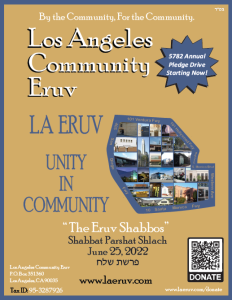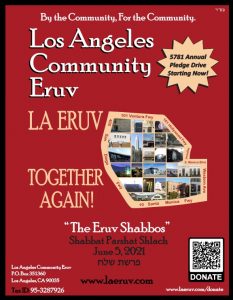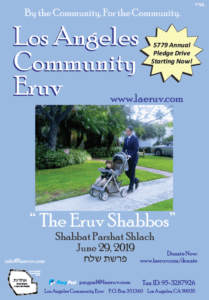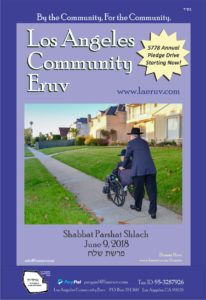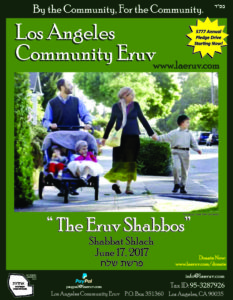Download our 5782 (2022) booklet by clicking the cover at the right:
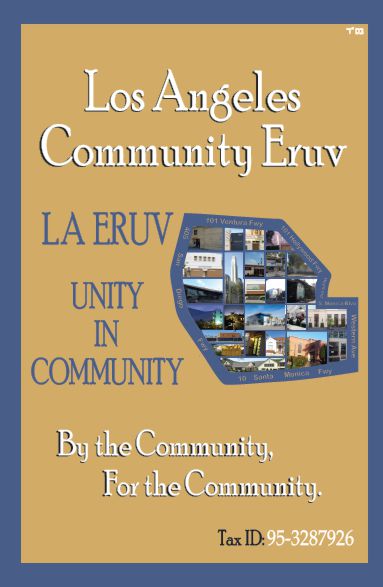
See also:
- Rabbinic Endorsements
- Building An Eruv – A Picture History
- Connecting to Street Lights
- Fixing the Eruv
- Permission from Los Angeles
- Rabbis in the Sky – Checking the Eruv
- The Teichman Adapter
RCC STATEMENT OF CERTIFICATION
RCC Kashrus Approval of Los Angeles Community Eruv
21 Teves 5763
December 26, 2002
The Rabbinical Council of California and the RCC Eruv Vaad Halacha certifies the validity and maintenance of the Los Angeles Community Eruv (LACE). This Eruv incorporates the highest standards possible in a large metropolitan Eruv.
Eruvin in large metropolitan areas are not certified according to all halachic opinions. For a comprehensive discussion of the differing views of the classic and contemporary Poskim pertaining to our Eruv, it is imperative that one read the Eruv Guidebook and / or review it with their Rav.
Rabbi Avrohom Union, RCC Rabbinic Administrator
Rabbi Gershon Bess, RCC Eruv Vaad Halacha
Rabbi Nachum Sauer, Rcc Eruv Vaad Halacha
Rabbi Avrohom Teichman, RCC Eruv Vaad Halacha
[Note: as of 24 Dec 2008, we are working to restore the original Hebrew to this website from the Word document original.]
RCC Guide to the use of an eruv.
L.A.’s new Eruv
A large part of the city of Los Angeles is included in a brand new eruv. The L.A. Community Eruv will extend to the east to include Hancock Park and its neighboring communities. It will also expand westward to include Westwood and North Beverly Hills. The exact boundaries of the current and future parts of the eruv are detailed at the end of this handbook, and may be seen on our website www.laeruv.com.
How is this eruv different?
This eruv is significantly different than any previous constructed eruv covering these areas. It is based on a set of halachic principles which raise it to a much higher standard, requiring a considerable amount of actual construction and many other changes in the eruv design.
For Whom is the Eruv?
Virtually no city eruv can be constructed to fulfill the Halachic requirements of all Rabbinic authorities. Historically, Klal Yisroel has relied on the use of citywide eruvin meeting specific Halachic criteria.
The city of Los Angeles, due to its large population and the traffic patterns of major streets, presents a situation which precludes reliance upon the construction and halachic principles of eruvin in many other cities.
Nevertheless, the Eruv Vaad Halacha, under the direction and supervision of the RCC, has consulted with leading Halachic authorities. Based on their directives, we have constructed an Eruv, incorporating the highest standards possible in a large metropolitan eruv. For example, the eruv uses three solid walls and does not rely on tzuras hapesach alone. The RCC, while endorsing the Halachic validity of the Eruv, is cognizant of the fact that there are Halachic authorities who do not permit carrying within an Eruv constructed in this manner.
Proper use of the Eruv
More than anything, the eruv was built to enhance the experience of Shabbos. More togetherness, better access to shul, additional options for the young and elderly, will all be facilitated by the eruv. But, in order to use the eruv properly, we should remind ourselves as to what the Shabbos experience means.
Shabbos has two aspects: Shamor and Zachor. Shamor entails refraining from anything which halachically is defined as melacha, creative activity. For example, we do not turn on electric lights, drive cars, or answer a telephone. Equally important is the aspect of Zachor. Aura and majesty are meant to accompany and complete our Shabbos experience. On Shabbos we eat different food, wear different clothes, sing zemiros and enjoy Torah study.
Like a wonderful recipe which is ruined if a necessary ingredient is missing, Shabbos will be reduced ?? ????? rather than enhanced if we are left with only Shamor and no Zachor. Improper use of the eruv will desecrate the spirit and even the laws of Shabbos. The following guidelines are part and parcel of the hashgacha and authorization of the eruv.
Not only would the RCC wish to withdraw their hechsher from the Eruv if improper use would chas vesholom result, but it is likewise incumbent upon baalei battim to insure that this does not happen. Therefore, Baalei Battim must take upon themselves the responsibility of speaking to such transgressors and forcing them to stop. Otherwise, the baalei battim themselves will demand from the RCC that they remove their hechsher since THEIR desire for an enhanced Shabbos has been thwarted. It is only based upon this commitment of cooperation and commonality of purpose that the RCC is willing to extend the hechsher for the new Eruv. The RCC will otherwise withdraw their hechsher.
Ball Playing
Absolutely no ball playing by adults is allowed on Shabbos, with or without an eruv. Poskim strictly prohibit ball playing by adults on Shabbos, and cite the Talmud Yerushalmi and Medrash Eichah which relate that the city of Tur Shimon was destroyed because of ball playing on Shabbos. Though Tur Shimon was a city full of religious and pious people, the severity of playing ball games on Shabbos led to its destruction. Ball playing by children in public desecrates the spirit of Shabbos. Ball playing by young children must be limited to one’s backyard. Need we say more?
Muktzah
The prohibition of muktzah safeguards us from prohibited activity on Shabbos and ensures that Shabbos is different from all other days of the week.
Many articles are “mukztah” and prohibited to move on Shabbos. Some of the more common are:
- Any item which has no Shabbos functional use such as pets, stones and credit cards.
- Any item so valuable that one expends extra care to protect and safeguard it such as passports, checks and other expensive items.
- Any item which cannot be used on Shabbos or whose intended use is for after Shabbos such as car keys or an umbrella.
Eruv “do nots”
Practically speaking, what we learned above means that users of the eruv are strictly prohibited from:
- using an umbrella
- riding a bicycle, scooter or using roller skates
WHAT IS ALLOWED
Commonly used articles that do not pose a problem on shabbos include:
- baby carriages and strollers
- canes, walkers and wheelchairs
- food (concerning giving/receiving presents on Shabbos, consult your Rav)
- handkerchiefs
- gloves and rain hats
- house keys
- a siddur or sefer
- medicines
One must be certain that any muktzah items are removed from the above before Shabbos starts.
Checking the status of the Eruv
The Rabbinical Council of California has committed itself to the ongoing supervision and checking of our eruv. In addition to the Eruv Vaad Halacha, an eminent Talmid Chacham, well versed in the intricacies of eruvin, has been hired to check the eruv weekly. Wherever and whenever a problem develops, we will move as quickly as possible to fix it. Nevertheless, weather conditions and other natural and manmade problems will sometimes cause every eruv to fail.
Therefore, nobody should use the eruv without making sure it is operational for that Shabbos. EVERY Erev Shabbos one should do one of the following:
- call the ERUV hotline at 877-ERUV-INFO and go to the eruv option to check the status of the eruv
- check the website www.laeruv.com which will show the status of the eruv.
- subscribe for weekly email eruv updates via the above web-site.
Please note that even if the eruv was up before Shabbos, a storm or strong winds during the course of Shabbos will presumably disqualify. In case of storm or the like assume the eruv is down and desist from its usage.
To avoid disappointment and inadvertent chilul Shabbos, no Kiddush, bar mitzvah, bris, aufruf, or other joyous event should be planned under the assumption that the Eruv will be operational. Preparations should proceed as if there is no eruv. Examples of such advance planning include that food should be brought to the location before Shabbos, a copy of the bar mitzvah boys’ speech should be brought to shul before Shabbos, and the like. One should not assume that an event will take place outdoors.
The following is an overview of the Halachic issued involved in the new Los Angeles Eruv and the improvements over the former Eruv.
I. The two components of an Eruv:
- In order to carry on Shabbos one has to create a “Reshus Hayachid” (“private domain”) – it has to be an area that is enclosed with Halachically valid “Mechitzos” (“Partitions”).
- To be “Me’arev” (“combine”) all people together within the Eruv area with the required amount of bread, and by executing a “Sechiras Reshus” (rental of property not belonging to Jews, and thus not part of the “combination”.). Historically, this has been accomplished by rental from the police or other governmental authorities.
The following relates to the first component.
II. Definition of “Reshus HaRabim” – Public domain
There are a number of criteria that have to be met in order for an area to qualify as a Reshus HaRabim:
- “16 Ammah” – The area must have a thoroughfare, which is approximately 24-32 feet wide. The street must be open to the public and it cannot have a roof over it.
- 600,000 people – There is a dispute among the Rishonim, whether a requirement of Reshus HaRabim is that 600,000 people use the street.
There is a major debate on how to define this requirement of 600,000 people, especially in light of the fact that the Shulchan Aruch states that we require 600,000 people “Ovrim Bo Bechol Yom,” which simply interpreted means that it has to be a street traversed by 600,000 people every day. However, this interpretation is difficult:
- Historically, when the Gemorah calls certain locales a Reshus HaRabim, it does not seem feasible that there were 600,000 people there each day.
- Pictures of the levaya of R’ Shlomo Zalman Auerbach zt”l, show that the city was clogged with 250,000 to 300,000 attending, so one cannot imagine 600,000 in a 16 Ammah-wide street each day.
- The Ritva states that the population of Yerushalayim was less than 600,000 people. Only by including the surrounding suburbs was there a population of 600,000. To imagine that all the people of Yerushalayim and of the suburbs all used the main thoroughfare each day is not feasible.
Granted that some Poskim do insist on the requirement of 600,000 each day, the consensus of Poskim [Chazon Ish, Rav Moshe Bick, Rav Yisroel Gustman, Rav Moshe Stern, Rav S.Z. Auerbach ?????? ?????, and Rav Elyashiv ????”?] interpret the Reshus HaRabim requirement to be a street, that services a population of 600,000 people every day. For example, in Brooklyn, Ocean Parkway is a wide street (three lanes each way) that services the people in the Flatbush and surrounding areas [more than 600,000 people]. It is considered a Reshus HaRabim even though 600,000 people will never use it on a single day. The Mishna Berurah shows that this opinion is supported by the Ramban and Ritva. ??’ ????”? ??’ ??”? ?”? ???? ????
The Poskim say that the “Machaneh Leviah” (Levite Camp), was considered a Reshus HaRabim, because whenever a person had a query to ask Moshe Rabbeinu, he would go to the Machaneh Leviah. The possibility that all of Bnei Yisroel had a sheilah every single day, and went there every day, is not at all likely. Rather, the “Machaneh Leviah” was available for the 600,000 to use everyday even though they did not all actually use it every single day. Therefore, consensus of the Poskim is that those major streets that are used by the people of the city, are considered streets that service 600,000 people every day.
R’ Chaim Ozer Grodzenski zt”l, felt that Paris was a Reshus HaRabim DeOraysa, fulfilling the requirement of 600,000 people, despite the fact that he states there were not 600,000 people on any street on any given day.
R’ Gustman zt”l was asked that if this is the correct interpretation of the Shulchan Aruch, how did Warsaw continue to keep their Eruv, even after the population there grew, and exceeded 600,000. He answered that Warsaw did not have main streets like Paris or Brooklyn, wherein there were 600,000 people from all around using those streets. Warsaw expanded in a manner that the people from the various parts of the city did not use any single streets, and rather each neighborhood used the adjacent streets. At the time there were no cars or wide streets, hence no major thoroughfares used by 600,000 people.
Los Angeles has streets such as La Brea, Wilshire, Olympic, and others, which are heavily traveled daily, and therefore should be considered a Reshus HaRabim Deoraysa fulfilling the criteria of “600,000” similar to Ocean Parkway in Brooklyn.
III. Constructing an Eruv for a Reshus HaRabim
The Shulchan Aruch cites two opinions as to how to construct an Eruv, which contains a Reshus HaRabim.
- We need “Delasos Neulos BaLayla” The city must [be walled and] have doors, that must be closed each night.
- We need “Delasos Reuyos Lehinael” – we do not require that the doors actually be closed every night, but rather there are doors, which are fit to be closed.
Based on the fact that the Shulchan Aruch seems to favor the opinions that a Reshus HaRabim does not need 600,000 and a Reshus HaRabim does require “Nightly closed doors”, the Mishna Berurah asks why in the European cities, which had streets 16 amos wide, [which according to many Rishonim suffices to create a Reshus HaRabim, even without 600,000 people] was there only an Eruv of “Tzuras HaPesach” (poles and string.) Based on the Shulchan Aruch, there should at least be doors which are fit to be closed, if not actually closed. The Mishna Berurah felt it difficult to rely on the opinion which requires 600,000 for a RH”R, because most Poskim do not require this.
Therefore, the Mishna Berurah justifies building an Eruv merely with a Tzuras HaPesach in the following manner:
The dispute brought in the Shulchan Aruch regarding “closed doors” is based [according to the Maggid Mishneh] on the dispute of R’ Yehuda and Chachomim, as well as R’ Yochanan and R’ Elazar as to whether “Ossei Rabim U’Mevatlei Mechitzta,” i.e. if a Mechitzah surrounds an area and there is traffic of the Rabim going through that Mechitzah, does that “break” (negate) the enclosure or not.
The first opinion cited by the Shulchan Aruch, based on the opinion of R’ Yochanan, [“Ossei Rabim U’Mevatlei Mechitzta”], requires the doors to be closed at night, so that at certain times traffic cannot traverse the walls. Otherwise, the traversing traffic would negate the “Mechitzah”.
The second opinion cited by the Shulchan Aruch, based on the opinion of R’ Elazar, [“Lo Ossei Rabim U’Mevatlei Mechitzta”], does not require closed doors since traversing traffic do not negate the walls.
The Mishna Berurah concludes that the historical Eruvin of Tzuras Hapesach were based on deciding the Halacha in accordance with the second opinion, that “Lo Ossei Rabim etc.”.
However, it would seem that we still require doors that are, at least, fit to be closed? The Mishna Berurah declares that according to the second opinion, the requirement of “doors fit to close” is not a Torah requirement, rather a Rabbinical requirement. Therefore, the Tzuras Hapesach fulfills the Torah requirement of Reshus HaYachid, thereby eliminating any possible Torah violation of carrying. Since the necessity of doors is only a Rabbinical requirement, one may then rely on the opinion that it is not, in fact, a Reshus HaRabim unless there are 600,000 in the city, thereby averting the Rabbinical requirement of doors.
There are two points in the Mishna Berurah which are novel:
- A perusal of the Poskim throughout the generations seems to show that historically the Eruvin were predicated upon relying on the opinion that we require 600,000 people for a RH”R. The Mishna Berurah, after concluding that most Rishonim do not require a population of 600,000 to qualify as a Reshus HaRabim, finds it difficult to rely on that opinion and rather relies on the opinion of Rav Elazar.
- The assumption that if one holds that “Lo Ossei Rabim etc.”, a Tzuras Hapesach Eruv suffices MiDeoraysa, is clearly a dispute among the Rishonim. From the Rambam it seems that a Tzuras Hapesach does not work MiDeoraysa, although he holds that “Lo Ossei Rabim etc.” [The Tzemach Tzedek proves that according to the Rambam a Tzuras Hapesach would not suffice MiDeoraysa from the wording of the Rambam, which states that a “Lechi” (pole), “Korah” (beam), or Tzuras Hapesach do not work in a Reshus HaRabim. Since a Lechi or a Korah clearly do not work MiDeoraysa (a Korah is merely a reminder, not an actual Halachic partition, and a Lechi clearly does not suffice as stated in the Gemorah Eruvin), the simple understanding of the Rambam would be that Tzuras HaPesach is in the same category, and does not work MiDeorasya.
In a city where there are 600,000 people, the conventionally accepted lenient basis of historical Eruvin (lack of 600,000) would obviously not apply. Likewise, the rationale of the M”B also will not apply and doors (at least, fit to be closed) are required to close all the major intersections [which is not feasible].
The only Halachically valid solution for a city that meets the criteria of 600,000 is suggested in a responsa of R’ Chaim Ozer Grodzenski ZT”L. He discusses the possibility of an Eruv in prewar Paris and proposes that if we have three walls of “Omed Merubeh Al HaParutz” (more wall than breach) and one seals off the breaches with a Tzuras HaPesach, there is no need for doors.
The responsa is based on the following: As mentioned, the Mishna Berurah states that we rely on the opinion of the Rambam that “Lo Ossei Rabim U’Mevatlei Mechitzta”. The Rambam states this explicitly in a case of “Shem Daled Mechitzos”. “A construction of four symbolic walls”; an area that is surrounded by four “corner posts” and thereby negating the necessity of doors. If an area is surrounded on three sides with true walls, it is at least equal to the “corner posts” and no doors would be required. This reasoning is explained in the Chazon Ish [107:5] and used by the Bais Ephraim [#26]. (It should be noted that the Bais Ephraim understands that both opinions [even if doors must be closed at night] hold that “Lo Ossei Rabim U’Mevatlei Mechitzta” thereby strengthening the responsa of R’ Chaim Ozer Grodzenski ZT”L.(
The leniency of R’ Chaim Ozer Grodzenski ZT”L is based on the Halacha following Rabbi Elazar that “Lo Asei Rabim etc.” In fact, the Mishne Berurah states that all Eruvin were primarily based on the opinion of Rabbi Elazar. If the Halacha would follow the opinion of Rabbi Yochanan, the only way to construct an Eruv in a big city would be to build a wall with doors that would be closed each night.
This is the basis of the Toronto, West Rogers Park, Chicago and the San Fernando Valley Eruvin.
In Halachic terms, the newly constructed Eruv is a substantial upgrade. Firstly, there are many intricate Halachos regarding the actual construction and placement of the Tzuras HaPesach. Our Eruv follows the more stringent opinion, while the former Eruv relied on various leniencies. Secondly, since most Poskim regard Los Angeles as meeting the criteria of “600,000”, a Tzuras HaPesach Eruv does not suffice, and an Eruv is only valid if constructed in a manner of “Omed Merubeh etc.” with the breaches closed by Tzuras HaPesach.
Rav Moshe Feinstein zt”l was undoubtedly the recognized Posek of the United States. As such, it would be inappropriate, perhaps even forbidden, to construct an Eruv which he deemed to be invalid. This Eruv, however, does meet the Halachic requirements of Rav Moshe Feinstein zt”l, as attested to in writing by his son, Horav Dovid Feinstein Shlit”a.
The following is a synopsis of the Shita of Rav Moshe Feinstein zt”l: While Rav Moshe Feinstein zt”l followed the lenient interpretation that a street is only considered a Reshus HaRabim if 600,000 people traverse it daily, nevertheless he introduced a second manner in which a heavily populated city can become a Reshus HaRabim. According to Rav Moshe Feinstein zt”l, even if there is no single street that is traveled daily by 600,000 people, nevertheless, if an 80 square mile area of a city is populated by enough people that one can assume that there are 600,000 people out on the street during daytime hours, this entire area would be considered a Reshus HaRabim, even though no single street has a traffic of 600,000 people.
Accordingly, Rav Moshe Feinstein zt”l posits that if a city has a population density in this “square” of 2 ½ to 3 million people, we can assume that there are 600,000 people on the streets at any given time. Rav Moshe Feinstein zt”l [??”? ??”? ?”? ??’ ?”? ??? ?’ ??? ?’] proves that merely having a population of 600,000 is not sufficient from the fact that Warsaw had an Eruv even though there were more than 600,000 residents. Since the relevant “square” in Los Angeles has a population of just approximately 700,000 people, even if we would combine commuter traffic, it would surely be permitted according to the guidelines of his responsa.
Rav Moshe Feinstein zt”l, in another responsa, restricts construction of an Eruv in a city that is densely populated and people would assume that there are 2 ½ to 3 million people in the “square” even though actually there are not that many people. Since Los Angeles is a very “spread out” city, one can reasonably assume that Rav Moshe Feinstein zt”l would not restrict construction of an Eruv in Los Angeles. His son, Horav Dovid Feinstein Shlit”a, in fact, has written to us that his father zt”l would permit construction of an Eruv in Los Angeles.
The Bottom Line
To properly understand “the bottom line” it is necessary to give an introduction to the way Halacha guides and determines our lifestyle. We would all like things to be “black or white”. “Just tell me; is it forbidden or permitted?” However, life is not so simple. There are many different situations in Halacha and each situation has its own definite rules and guidelines. We will present a number of situations and their guidelines:
- If there is a dispute among the Poskim regarding a certain issue and the consensus of the Poskim is to decide the manner according one opinion, we are mandated to follow that opinion.
- If there is a dispute among the Poskim and there is no consensus, if the question is regarding a Torah prohibition, we are mandated to follow the stringent opinion. If the issue is regarding a Rabbinical prohibition, we are permitted to follow the lenient opinion.
- The Shulchan Aruch will sometimes declare that a certain food is forbidden unless there is a great loss of money, in which case one may follow the lenient opinion. This is seemingly difficult to understand. Even if one were to lose all of his assets he is not permitted to transgress a prohibition. How then may he be lenient in case of great financial loss. The Ramoh explains, that whenever we allow leniency in cases of loss, it means that in truth we have decided the issue according to the lenient opinion. However, since there are many opinions that rule stringently, we are only permitted to follow the lenient opinion in case of financial loss. Now, if one were to say that since the true Halacha follows the lenient opinion, I would like to follow the lenient opinion even when there is no loss of money, he would be transgressing the Halacha. If the Shulchan Aruch decides that one can only be lenient in cases of great financial loss, then we are mandated to follow the stringent opinion in all other cases
- At times there is a Halachic situation when most Poskim decide according to the lenient opinion but, nevertheless, there are reputable Poskim that decide the issue stringently. The later Poskim may decide that in this case, though the Halacha follows the lenient opinion, nevertheless, since there are reputable Poskim who decide the matter stringently, they recommend that one act stringently, since there has not been a clear consensus to be lenient. In this case, one is not mandated according to Halacha to follow the stringent opinion but one is recommended to do so.
- There may be a dispute among the Poskim and the consensus is to be lenient, or, the Jewish nation generally accepted the lenient opinion, but there are nevertheless, dissenting Poskim. In such a case, the general populace is not suggested to act stringently, but those seeking a higher level of observance are recommended to act stringently.
Historically, the type of Eruvin constructed in the small towns fell into the fifth category; the general public practiced leniency while the “Baal Nefesh” (those seeking a higher level of observance) were recommended to be Machmir.
Los Angeles, a city with a population of a few million, with streets that are relatively straight and extend for miles and service 600,000 people is unique. On the one hand, as stated clearly in the Responsa of R’ Chaim Ozer Grodzenski ZT”L, Los Angeles is definitely considered a Reshus HaRabim of 600,000 making our city more stringent than the small towns in Europe. On the other hand, the construction of an Eruv utilizing “walls” is better than the European Eruv which consisted solely of a Tzuras HaPesach.
How does one weigh the efficacy of an Eruv built with three walls with its breaches closed with a Tzuras HaPesach in a city with 600,000 people, and under which of the abovementioned categories does it fit? How would our contemporary Poskim classify the proposed Eruv in Paris?
This question was submitted to leading Poskim of our generation: Their response ranged from: “The Eruv should be relied upon only in case of true necessity” [?? ????? ?? ?????? ???? ????, ??? ???? ???? ?????? ??? ???? ????.] to “The decision to act stringently is one’s own private decision.”[[ ????? ?????? ????? ?????
The RCC accepted to supervise the construction and maintenance of the Eruv and to certify it as Kosher, within the abovementioned parameters.
Click a flyer to download that year’s campaign booklet (no booklet in 2020/5780):
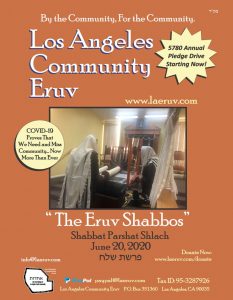
2020
